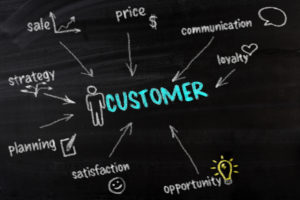You may have heard Theodore Roosevelt’s quote, “the more you know about the past, the better you are prepared for the future.” While Roosevelt certainly couldn’t have envisioned today’s technological landscape, his adage holds true when considering big data and predictive analytics: The very premise of predictive analytics centers on learning from the past to make predictions about the future for your company.
Predictive Analytics: What is it?
Predictive analytics helps companies make inferences about future customer behavior by looking at past data. To conduct predictive analytics, companies need to analyze past customer data. This might include products purchased, the number purchased, costs, etc. Other data pertaining specifically to customers and what may influence their likelihood to purchase a product (e.g., location, industry, company size, etc.) are then considered in relation to the past data.
Using regression analysis, companies can determine which independent variables pertaining to customers are correlated with customers purchasing a product. The resulting regression equation reveals how strongly each independent variable influences customer purchasing behavior (i.e., regression coefficients). This can create a score that predicts how likely certain types of customers are to purchase a product.
Predictive Modeling to Target Customers
By determining which variables most strongly influence customers, regression analysis creates a predictive model from patterns that emerge from the data. Predictive modeling helps you determine what your next step should be. It aggregates your data and provides you with a profile of your ideal customer – who is most likely to buy your product, which product they will buy, when they will buy it, etc. This allows you to identify customers you may have missed previously and more strategically target them based on their likelihood to buy your product. Predictive modeling helps you focus on targeting those most likely to buy your product rather than expending time and energy on markets that likely won’t.
Triangulating the Data
Predictive analytics requires you to triangulate your data. It’s not simply looking at one past sales or marketing campaign; you must analyze a variety of channels. Monitor social media networks. Look at digital marketing tools. Consider which demographics respond to your marketing strategies. Determine supply and demand for your product. The more you can enrich your data, the more precise your predictive model will be. Often previously overlooked relationships can now be valuable opportunities for growing your customer base. The amount of usable data collected by the internet is endless, and the power of predictive analytics is in its ability to triangulate and make sense of big data to reveal relationships between both obvious and seemingly disparate factors.
Developing a Strategy
Simply performing a regression analysis is not sufficient. The predictive model developed from your data is valuable, but it’s based on numbers. Your model will only be successful if you can humanize that data. The data tells a story about your customers, and you need to extend this story from customers’ past purchases to the present. Developing a marketing strategy based on the data to target your customers and test your approaches is a critical step in utilizing big data. While computers can run the analysis, you still need to recommend the course of action for reaching customers.
Assumptions
An important factor in any statistical model is the underlying assumption(s). In predictive analytics, a key assumption is that people’s behaviors will remain consistent. One of the great aspects of big data is that it can provide real-time insight into customers’ needs and behaviors. However, technology changes quickly, which may, in turn, adjust customer actions. With customer data continuously being gathered, it’s important to regularly monitor your data to ensure that they’re current and relevant; it may be necessary to frequently re-run your analysis. Predictive models are only as good as the data on which they’re built, and if your data is out-of-date, so is your predictive model and strategy.

